- Occasionally I recycle a favorite older blog post because most current viewers have never seen it. This one was published on August 26, 2012 (I’ve posted two other photos of this bird since that time). I’ve reprocessed the images and rewritten some of the text.
Western Montana had been awash in Swainson’s Hawks that summer. From the Canadian border (Glacier County) to the southwestern border with Idaho (Beaverhead County) I found them in significantly larger numbers than I’d seen in previous summers. I hope that anecdotal observation was accurate because their numbers have been declining to the point where they’re listed as a Species of Special Concern in several western states.
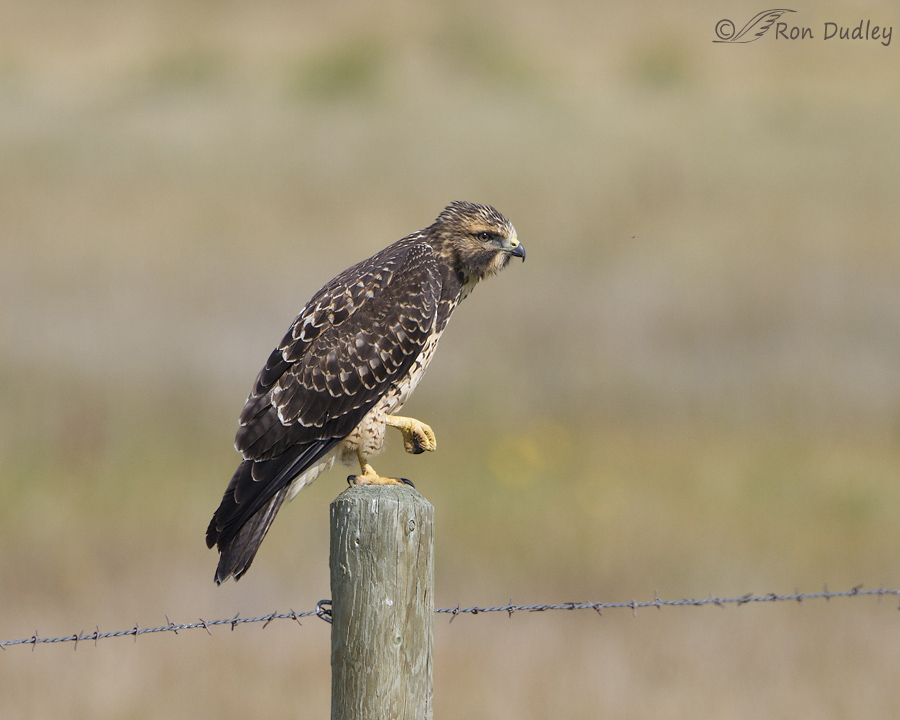
1/2000, f/7.1, ISO 500, Canon 7D, Canon EF 500mm f/4L IS I USM, not baited, set up or called in
I found this handsome juvenile along a county road in Beaverhead County in late August. At first it was very relaxed and assumed this clenched fist pose that is so typical of many buteo species when they’re at ease and resting.
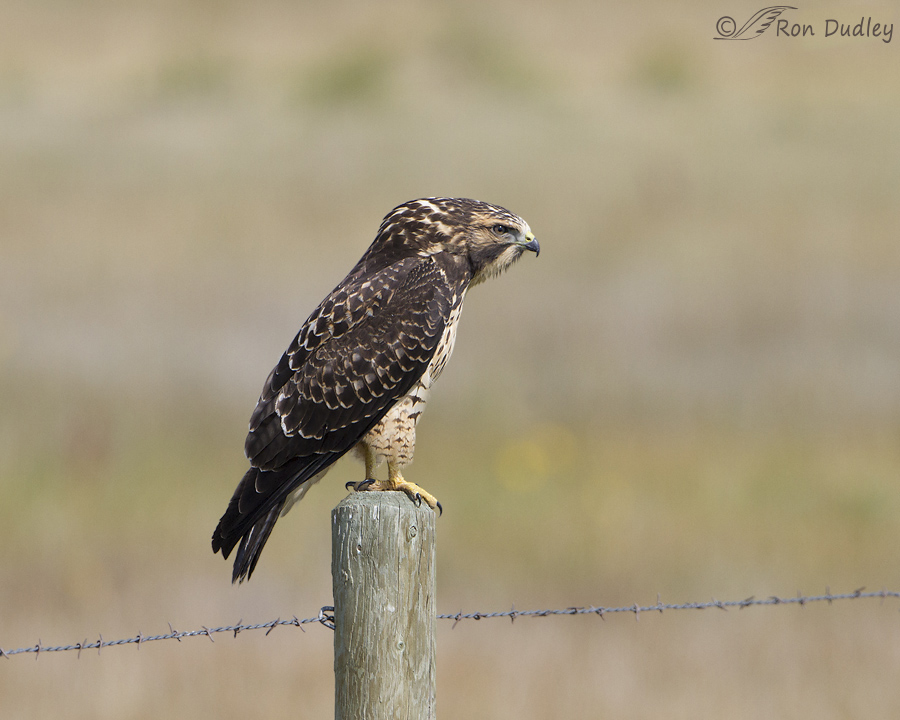
1/1600, f/7.1, ISO 500, Canon 7D, Canon EF 500mm f/4L IS I USM, not baited, set up or called in
But soon it began to arch its neck and raise the feathers there and I recognized that it was about to attempt to expel a pellet. I had already removed my teleconverter in anticipation of take-off so I decided to leave it off because so often in the past I’ve missed the falling pellet as it dropped out of frame at bottom if I was too tight on the bird.
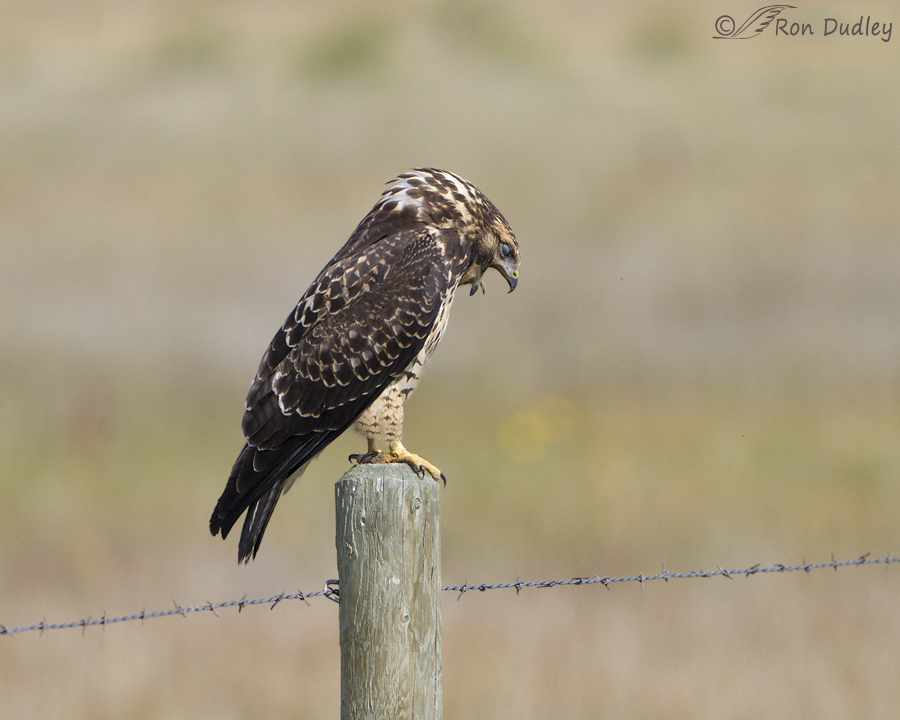
1/2000, f/7.1, ISO 500, Canon 7D, Canon EF 500mm f/4L IS I USM, not baited, set up or called in
Then, with the nictitating membrane pulled over the eye, the bird began to retch.
These few images showing pellet ejection may give the viewer the impression that it all happened very quickly. It didn’t. From beginning to end the whole process took over four minutes. During that time there were alternating periods of retching and resting and it didn’t look to be a particularly pleasant experience for the hawk.
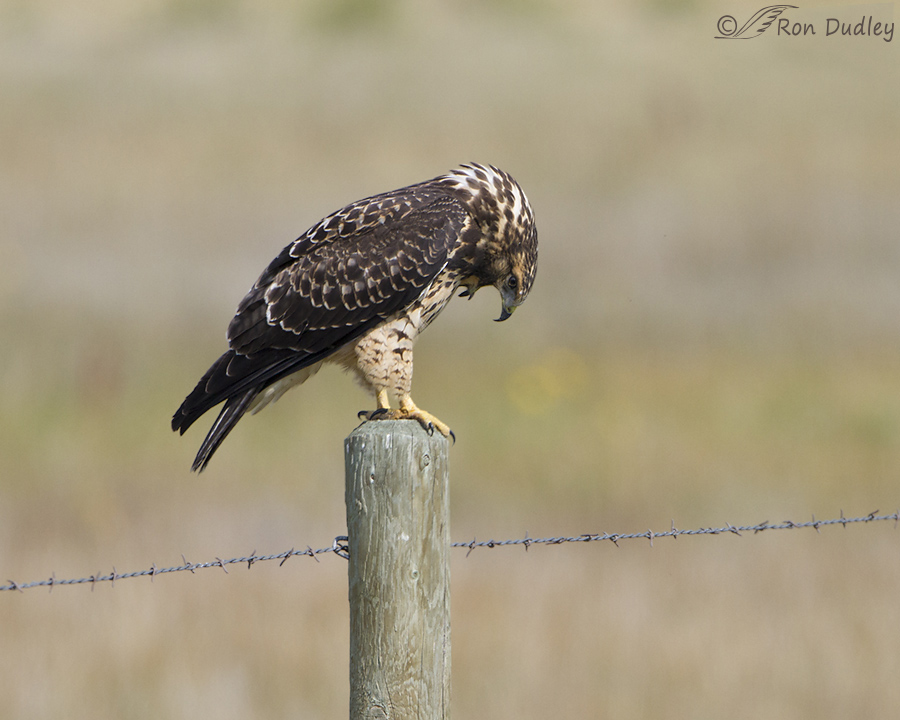
1/2000, f/7.1, ISO 500, Canon 7D, Canon EF 500mm f/4L IS I USM, not baited, set up or called in
There was no light in the eye in many of my images but I wanted to include a shot with the bird in this posture to show the effort required to expel the pellet.
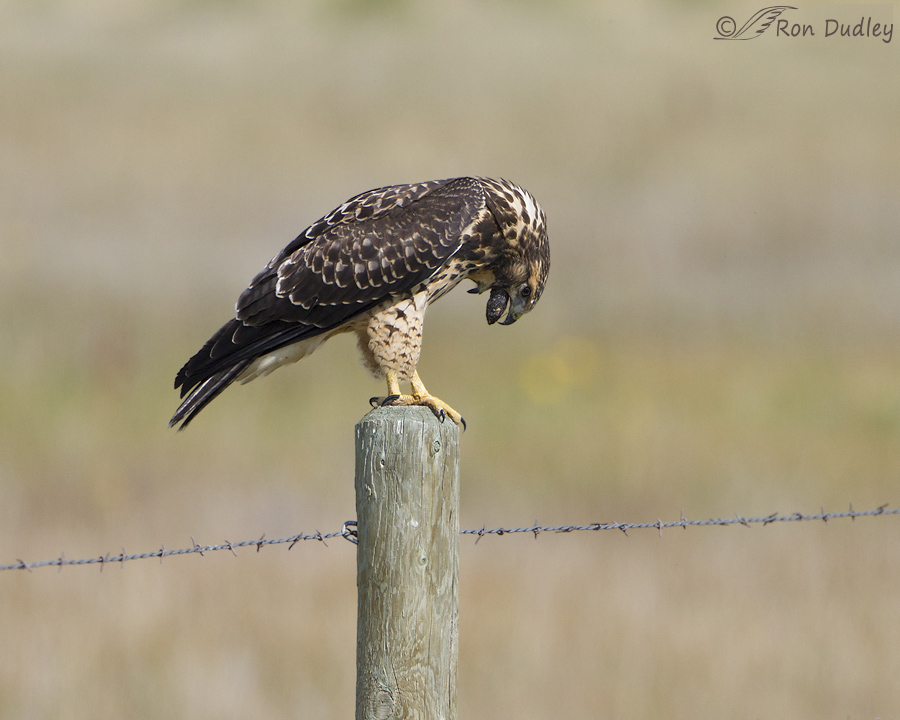
1/2000, f/7.1, ISO 500, Canon 7D, Canon EF 500mm f/4L IS I USM, not baited, set up or called in
Here the pellet begins to emerge.
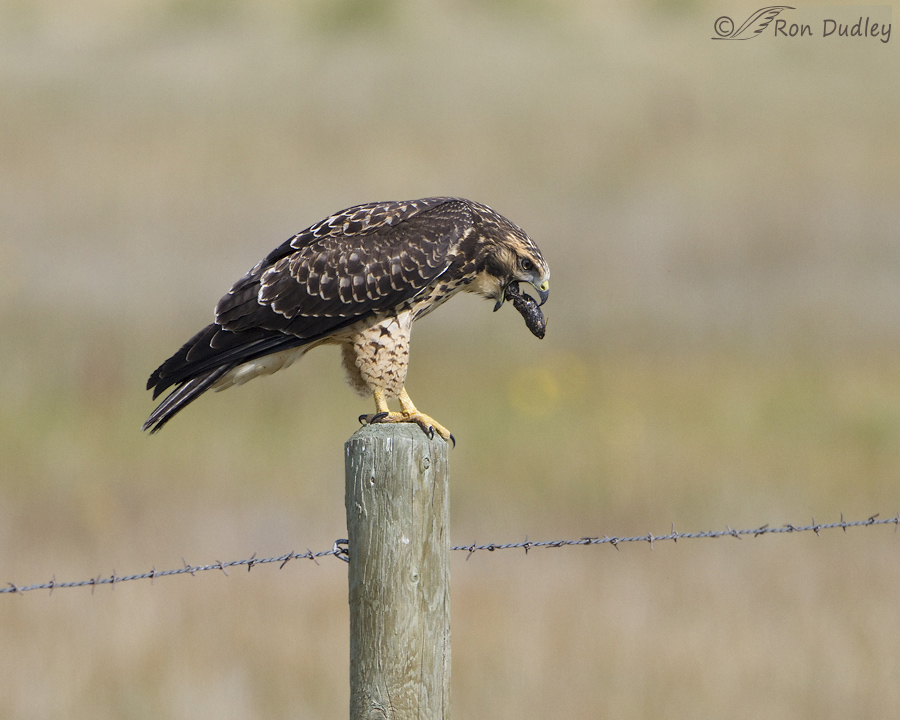
1/2000, f/7.1, ISO 500, Canon 7D, Canon EF 500mm f/4L IS I USM, not baited, set up or called in
As the first pellet clears the beak we can see that there’s a second pellet lined up right behind it.
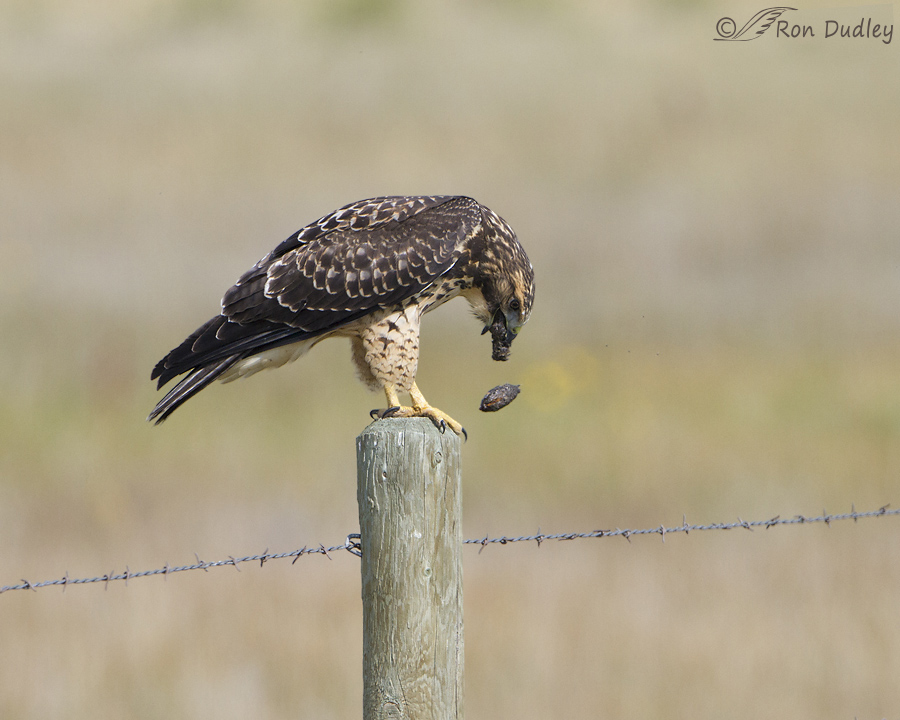
1/2000, f/7.1, ISO 500, Canon 7D, Canon EF 500mm f/4L IS I USM, not baited, set up or called in
As the first pellet fell away the second one was still partially in the mouth of the hawk.
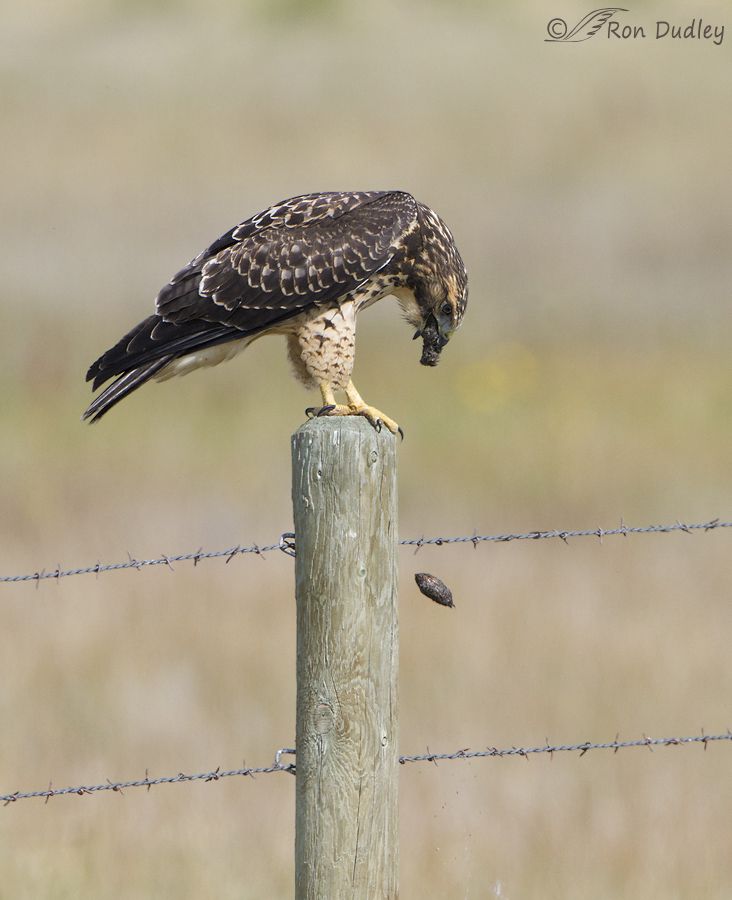
1/2000, f/7.1, ISO 500, Canon 7D, Canon EF 500mm f/4L IS I USM, not baited, set up or called in
But the larger second pellet was a little stubborn.
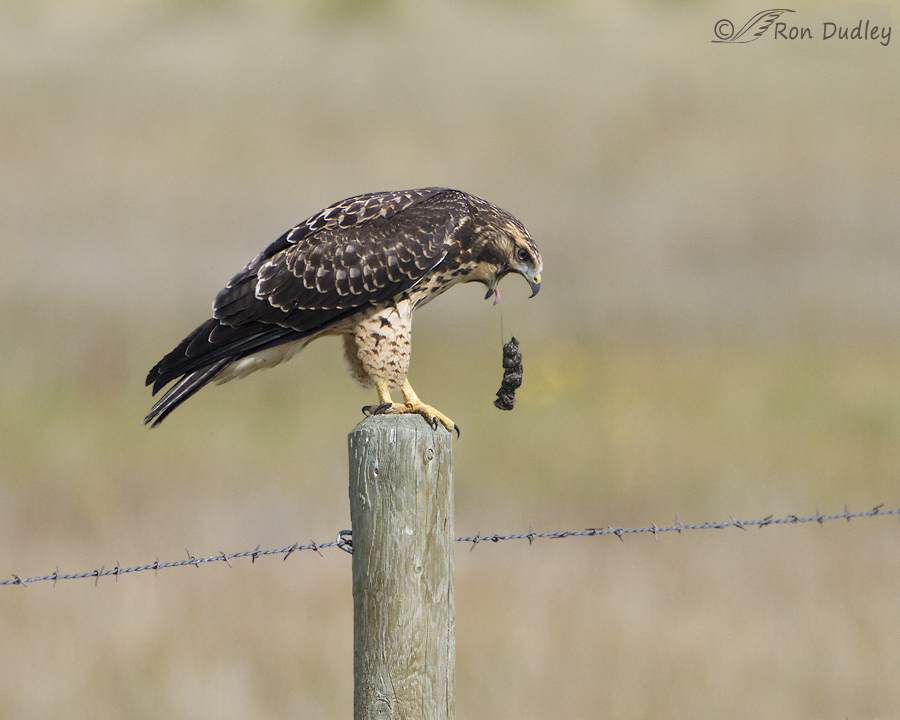
1/2000, f/7.1, ISO 500, Canon 7D, Canon EF 500mm f/4L IS I USM, not baited, set up or called in
Then the second pellet finally emerged…
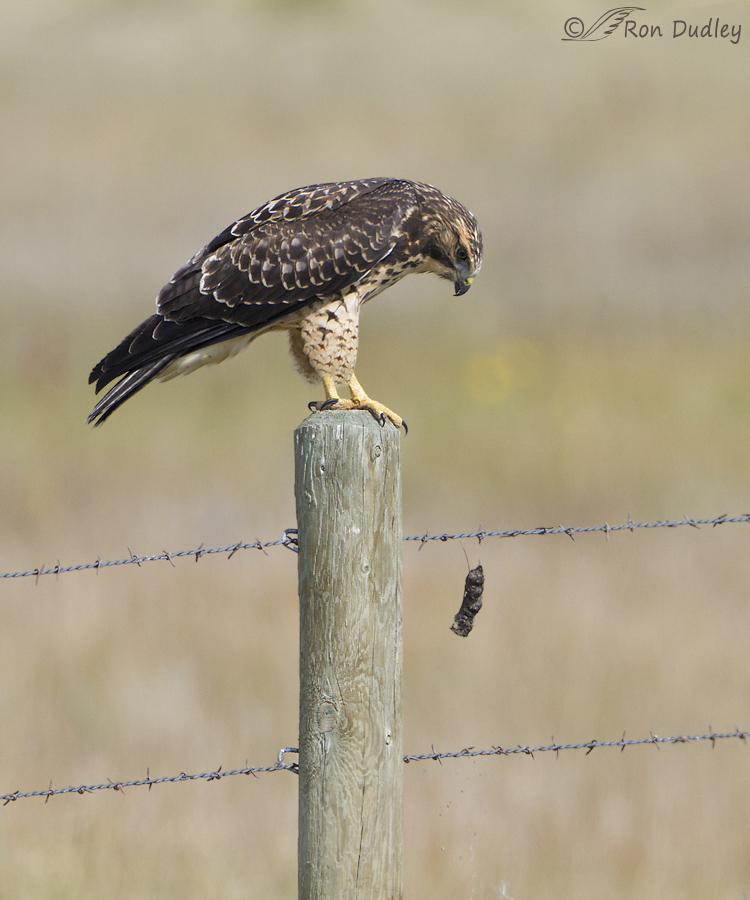
1/2000, f/7.1, ISO 500, Canon 7D, Canon EF 500mm f/4L IS I USM, not baited, set up or called in
and fell to the ground.
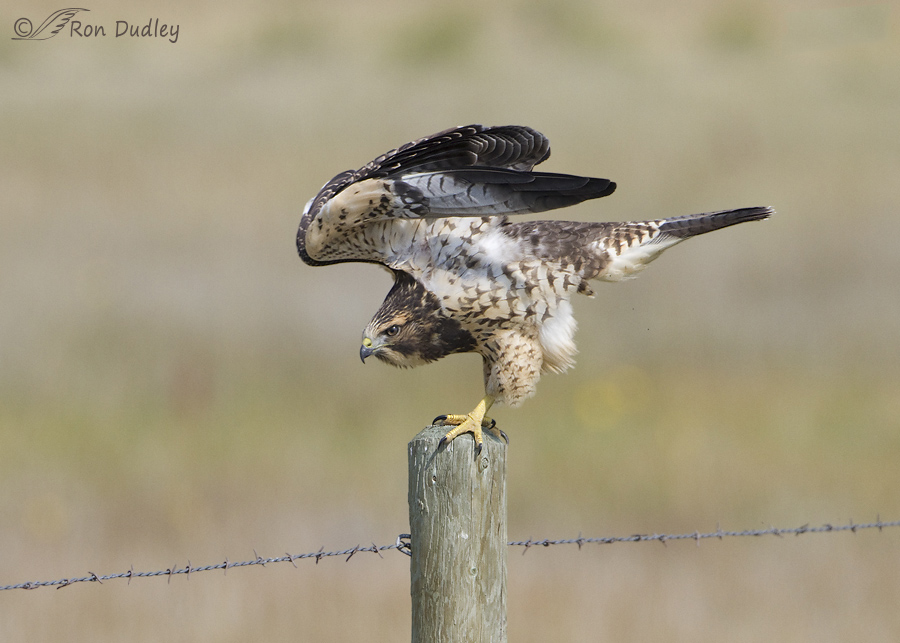
1/1600, f/7.1, ISO 500, Canon 7D, Canon EF 500mm f/4L IS I USM, not baited, set up or called in
Soon after the last pellet was ejected the hawk turned on the perch and gave me a nice wing stretch – almost as if to demonstrate its relief that the whole unpleasant experience was over.
![swainsons-hawk-pellets-0056-ron-dudley[1]](https://www.featheredphotography.com/blog/wp-content/uploads/2017/01/swainsons-hawk-pellets-0056-ron-dudley1.jpg)
When the hawk flew off I was able to retrieve both pellets from beneath the fence post – still wet and warm.
![swainsons-hawk-dissected-pellets-0103-ron-dudley1[1]](https://www.featheredphotography.com/blog/wp-content/uploads/2017/01/swainsons-hawk-dissected-pellets-0103-ron-dudley11.jpg)
When I arrived home a few days later I carefully dissected both pellets.
They consisted almost entirely of small mammal fur (meadow voles?) with only four small bones (they appeared to be ribs, not teeth) and two tiny bone fragments along with a few stray grass stems. There were no chitinous insect exoskeletons to be found and that surprised me. I know that grasshoppers form a major part of the diet of Swainson’s Hawks and in past years I had observed these birds eating grasshoppers in the same area. There were grasshoppers galore where I found this bird so I had assumed it was primarily eating Orthopterans.
So I did a little research. It turns out that Swainson’s Hawks do eat mostly insects, especially grasshoppers, for much of the year but during breeding season they switch their diet to rodents, rabbits and reptiles.
Yet another reminder of the potential pitfalls of making assumptions…
Ron


Ron,
That’s some real dedication.
Stephen
WOW again. As always your posts are a delight and an education, ( and a treat as well) I feel so much for these creatures as it looks really really hard to throw the pellets. The size of those 2 were mind boggling to me.Thanks for sharing this post again
Amazing photos!!
Great series, Ron.
which pellet was the dime in?
Neat photo essay Ron. You did a great job capturing the entire pellet expulsion process.
Sometimes I see them in large flocks hunting rodents behind the agricultural equipment during harvest. They end up getting right behind the equipment where the rodents scurry from harvesting.
Excellent behavioral series, Ron! Makes me wonder why the nictitating membrane was closed during part of the process???
I’m not sure, Diane. It may have been just momentary coincidence.
Definitely better out than in. That looks like a truly horrendous experience. Not a good start to the day for that poor hawk. And yes, I know, my anthromorphism is on display.
A fascinating series. And of course you dissected it. And I am grateful you did.
“And of course you dissected it”
EC, are you implying that I’m predictable? Nah, not me. Not ever… 🙂
Hi Ron
To my knowledge, while Swainson’s will eat grasshoppers/insects while up north, they do, as you said, mainly switch to eating small mammals
and rodents. When they are wintering down in South America, their diet is primarily made up of grasshoppers and other insects.
I think they are one of the only migrating raptors who so significantly change their diet from wintering grounds to breeding grounds.
It’s really very cool!
Karen, I’ve watched them gorge themselves on grasshoppers in the Centennial Valley of Montana many times during the summer. But they also eat voles and possibly ground squirrels up there. Perhaps they only restrict themselves to small mammals while they’re actively nesting or feeding chicks. I dunno…
Fantastic series and interesting info Ron!
Charlotte
Thanks, Charlotte.
Would you believe that I still have the first several pellets Mariah (RTHA) ejected way back when she first joined me 24 years ago? I do. I’m an old softie romantic 😉
I love showing folks hawk/owl pellets and I’ve got a good collection of them for education programs. What the Swainson’s pellet tells me is that s/he’s eating well and often and that’s great news! Another one of those Hmmmm…why questions is why they switch from insects to small mammals for breeding time? I KNOW there’s a good reason for it otherwise, they wouldn’t do it. But the why part…hmmmm!
Mariah ate an exoskeleton creature once and I was fascinated that the whole exoskeleton came out intact, just without the life part. I’m so easily amused. Have I mentioned that I just love hawks/raptors/critters in general?
And I’ll bet you packed those old pellets of Mariah’s with you all the way from NY to AZ when you moved, didn’t you, Laura! 🙂
I’ve read that the switch in diet at nesting time is because of their extra need for protein to feed their growing chicks. Many songbirds do something similar – going from a diet of seeds for most of the year but switching to insects for the nesting season.
Maybe it has something to do with having more to feed the chicks? There’s more meat on a gopher than on a grasshopper…
And about your move to arizona: prepare for the heat! It’s a lot different out here than back east! Here in southern CA we get a lot of triple digit days (sometimes even up to 113 or even 117; the record is 134) and not a lot of rain (though when it rains, it rains torrentially). For me, the hotter the better (so long as it’s not humid)!
Have fun in Arizona!
Let me say one more time how much I LOVE your posts, Ron. You keep it real…thanks.
Good! And I’ll continue to “keep it real”…
Poor hawk! That looks to be such an unpleasant experience! Sort of reminds me of banging my head against a brick wall (something we do a lot of in education! 😉 ) — it feels sooo good when it stops!
And as far as the “wet and warm” and dissection shots go, I’d expect nothing less. (And I’d be right in there with you!) I agree with Dick about the interesting differences between hawk and owl pellets. I used to give my kids extra credit for articulating the rodent skeletons as best they could. Occasionally, a pellet contained two skulls, so I had to caution the kids against getting too creative.
I’ll bet your kids occasionally come up with some interesting skeletal “hybrids”, Marty.
Good Morning Ron,
I read your blog every day and always enjoy it. I love your pictures but even more the information you share. You must have been a wonderful teacher.
Thank you so much for starting my day with joy!
I did love my career in the classroom, Len. Missed my kids and the interaction a lot when I first retired but the “peripheral stuff” – not so much.
This was not the post for me to read before breakfast, but documents the pellets and their regurgitation very nicely. I really like the wing stretch shot.
Thanks, Susan. I hope you can enjoy your breakfast anyway!
Those were surprisingly big pellets…poor bird must have felt a lot better with both of those gone….the price of being able to fly….
The bird seemed extremely relieved to have it done, Patty.
Great educational post. Good reminder that the life of those on the wing is not all twirls and swirls. Predator and prey alike have a price to pay in many ways just getting by day to day, thanks for the insight, hope to see more.
Thank you, Ron.
VERY interesting! It sure didn’t look like the hawk was having any fun! Also interesting as to what they digest and don’t – wonder if they every kill themselves choking on the pellets? Great photo’s of the sequence of events. 🙂 As I read this I’m listening to a pair of GHO’s in the yard – getting close to nesting time. 🙂
Judy, I’ve never seen or heard of a raptor actually choking to death on a pellet but I once photographed a harrier that I thought might be killed by the process. It was so distressed that it actually fell off the perch but it eventually recovered.
As usual great shots Ron. I particularly like the sequence and the fact that two pellets are ejected.
What interests me was that within the hair so few bones were recovered. I used to do this as well as have my class do Owl pellets and we could almost put together an entire vole/mouse skeleton from dissecting the pellets. Interesting the difference you found compared to what we used to see with Owl pellets.
Very interesting post, many thanks.
Dick, perhaps the recent prey of this bird was too large to swallow whole or in large pieces.
But most likely the lack of large numbers of bones in these pellets is due to the fact that the digestive juices of hawks are much more acidic than those of owls (owls don’t have crops) and most of the bones were digested.
Thanks, Ron, for the detailed series, and for the dissection display. Well done and informative.
I’m glad you enjoyed it, Dan. Thanks.
Great series Ron, and it looks like an absolutely miserable experience for the bird, but a great relief once its over. Great biology lesson as well. To actually catch this stuff in the wild is always a thrill. Loved it but had somewhat of a visceral reaction when I first went thru the images. Thanks for that with my 3rd cup of coffee!
Frank, this bird definitely wasn’t having any fun. It’s relief was palpable when it was all over. Hope I didn’t ruin the enjoyment of your coffee! 🙂
That’s ok, don’t worry about about it. 🙂